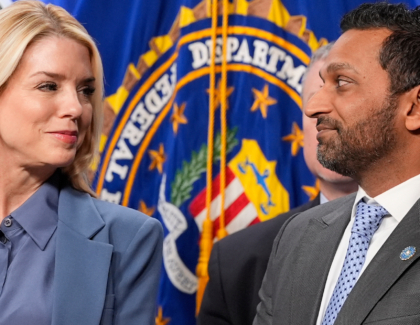Sign up for the daily CJR newsletter.
If it’s still the case that new trends start in California, the state’s 2010 Senate election may really be one to watch: voters have a wide variety of choices, and a range of outcomes seems possible.
The three-term incumbent and presumptive Democratic nominee, Barbara Boxer, is one of the more reliably liberal members of the Senate. She’s expected to face a tough fall campaign against whomever emerges from a three-way Republican field: frontrunner Tom Campbell, a establishment Republican who’s served in Congress and as Arnold Schwarzenegger’s finance director and jumped into the Senate campaign from the governor’s race just before the filing deadline; Carly Fiorina, the former Hewlett-Packard CEO and self-styled political outsider who recently picked up Sarah Palin’s endorsement; and Chuck DeVore, an Orange County assemblyman playing the role of the conservative insurgent. (The top vote-getter in the June 8 primary advances, even without an outright majority; there won’t be a runoff.)
Nothing in the Golden State, including politics, stays below the radar for long; the race has been on the national media’s agenda for some time now. But in search of some local knowledge, we reached out to Anthony York, editor of the Sacramento-based Capitol Weekly. His thoughts on some of the factors that may play a role, edited and condensed, are below.
1. The national debate over the direction of the Republican Party is shaping the primary discussion. But when the GOP has enjoyed statewide success, it’s usually been with more moderate candidates, and with the Democratic incumbent looking vulnerable, electability concerns are real.
This fight for the soul of the Republican Party that’s going on nationally, a couple of those battles are being waged here in California. You’ve seen immigration leap to the forefront of the governor’s race, given what’s gone on in Arizona, and we haven’t had a discussion about immigration in this state for the last fifteen years, since Prop 187. I think both of these races have been nationalized a little bit, though we haven’t seen a whole lot of outside national money yet in the Senate race. I do think you’ll see a lot more in November—for a lot of groups it’s a higher priority to either defend or defeat Barbara Boxer than to influence the primary.
The Tea Party candidate in this Senate race, if there is one, is DeVore. But electability and fundraising factor into the equation as well; DeVore doesn’t have the fundraising base or the institutional support that Campbell and Fiorina have. And California has not elected a pro-life Republican at the top of the ticket since 1986, when George Deukmejian was elected governor. The last time a Republican won a primary on the way to a statewide win at the top of the ticket in his first run was Pete Wilson in 1994. The California Republican base is very conservative, but when the party has been successful, it’s been able to reach out to moderates. Like anybody else, they want to win.
And Boxer, since she was elected—since she was nominated in 1992—has been widely seen as vulnerable. The conventional wisdom at the time was that if Campbell had won the Senate primary against Bruce Herschensohn that year, then he probably would have beaten Boxer. Through some combination of luck and political skill, she’s managed to survive, getting re-elected twice. 1998, when she first ran for re-election, was a landslide year for Democrats in California—there was the backlash to impeachment; Gray Davis crushed Dan Lungren in the governor’s election. In 2004, the Bill Jones campaign was not very well funded; it was also a presidential year, which are always better for Democrats out here because you get a better turnout. This year, Republicans are especially eager and see a really good chance to knock her off because of what’s going on nationally, and they want to elect the strongest candidate to try to accomplish that.
2. The Senate race might determine who controls Capitol Hill. But at least during the primary season, it’s playing second fiddle to the campaign to succeed Schwarzenegger.
Certainly the governor’s race (in which Republicans Meg Whitman and Steve Poizner are battling it out for the right to run against Democrat Jerry Brown) is sucking up more attention than the Senate campaign. The amount of money being spent there is awesome. Whitman has already spent more than $75 million, Poizner has spent $15 to $20 million, and we’re starting to see some of the independent expenditure money come in as well. It’s competitive just to get on the air, let alone get a message through.
That’s got to complicate things for candidates running up and down the ticket, and also in the U.S. Senate race. In terms of trying to get a message out, for someone like Chuck DeVore, who’s trying to play catch-up according to all the polls, that task becomes more difficult.
One interesting thing, and maybe this is tied into the governor’s race sucking up all the oxygen, is that there’s an increased importance on ballot designation, the three-word description you’re allowed to use on the ballot. DeVore bumped from 5 or 6 percent to 14 or 15 percent in a recent poll, and the assumption was that it was because of his ballot designation. In most earlier polls, he was referred to as an assemblyman—not a very good ballot designation in this anti-incumbent atmosphere. But his actual ballot designation is “legislator/military reservist,” which is much better, especially in a Republican primary.
Related to that, Carly Fiorina’s ballot designation is “business executive.” Not just businesswoman, but business executive—which, in this climate, could prove to be a mistake. That could be erased by a vigorous paid media campaign, but if a candidate can’t break through, I’m not sure that’s what you’d want voters to know about you.
3. Voters in the Republican primary might not all be Republican. And some of them will start casting votes this week.
Voters who decline to state a party preference, who make up about 20 percent of the state’s electorate, are eligible to vote in either primary. This year, you’ve got competitive Republican primaries in both the U.S. Senate race and the governor’s race, and no competitive primaries on the Democratic side in either race. The modeling from the Whitman campaign estimates that 8 to 10 percent of the voters in this Republican primary will be decline-to-state. That might be a little high, but that’s the number they’re citing.
The majority of decline-to-state voters in California lean Democratic, but I don’t know if that would help someone like Campbell in this race or not. It’s very expensive to go after those voters, and you don’t see a lot of targeting and messaging directed at them, on the assumption that while they may participate in the primary, they’re not going to be swayed by a message that’s any different than the typical primary voter.
The other factor to think about, structurally, is absentee voting. Ballots went out Tuesday, and it’s estimated that more than half of the voters in the Republican primary will be by absentee ballot. Some of those get handed in late, closer to Election Day, but about a quarter of them get returned in the first week. So Election Day starts now. Folks can’t just go on the air in the last two weeks and hope to move the needle by ten points, because the election is actually a month long.
Has America ever needed a media defender more than now? Help us by joining CJR today.






